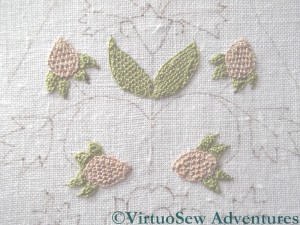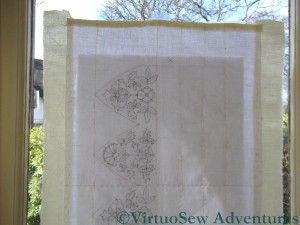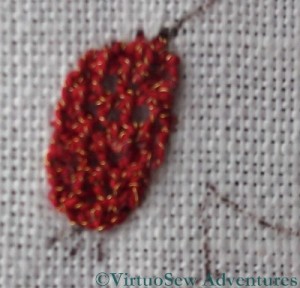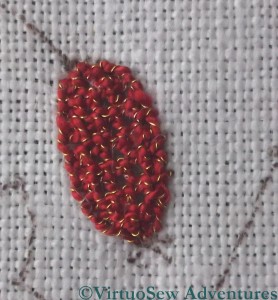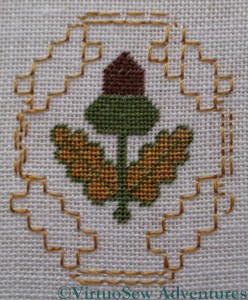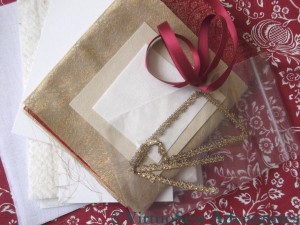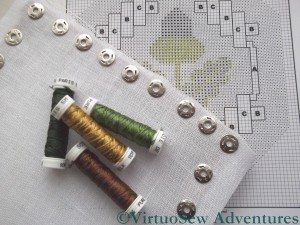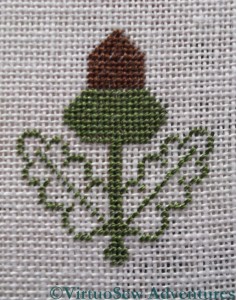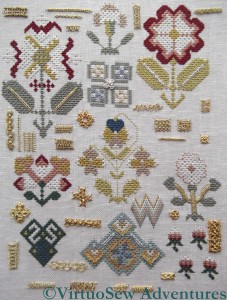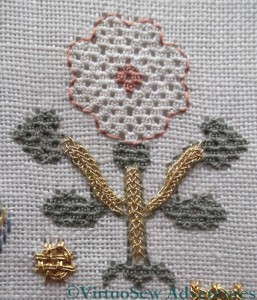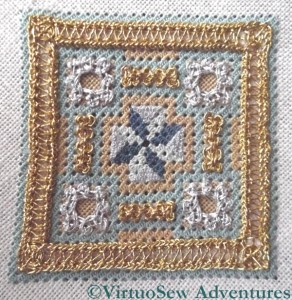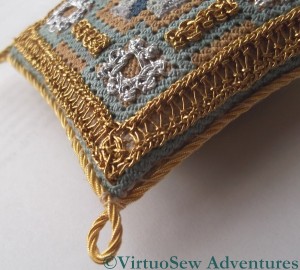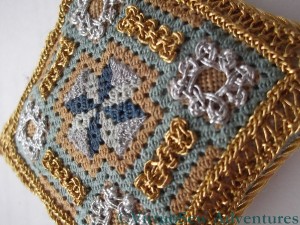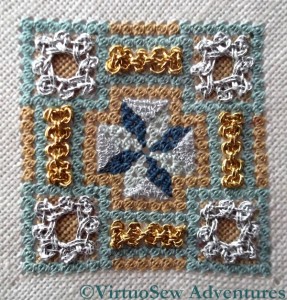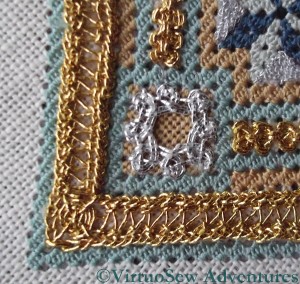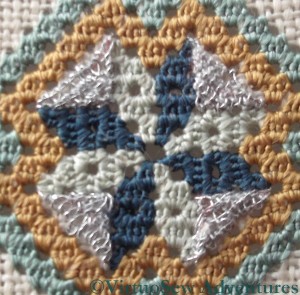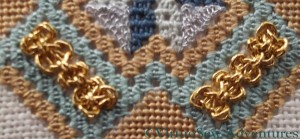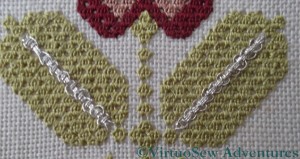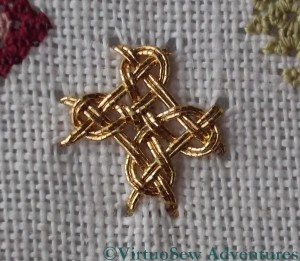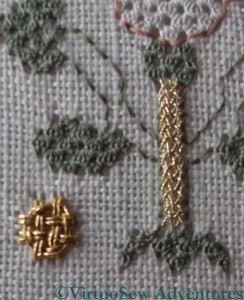Tag: online university
Progress on the Glittering Gentleman’s Nightcap
As you might have guessed, once I got started, I wanted to keep going!
However, detached buttonhole stitch is a very time consuming stitch, and I’ve been warned by comments in emails that the Gilt Sylke Twist, undeniably gorgeous though it is, can be a bit trying to stitch with. So I have been working quite hard to remind myself it is not a race, and that doing as much as I feel up to at any one time is perfectly acceptable!
I found myself struggling with the Millenium frame on my existing frame stand, which was too flimsy for the breadth and weight of the frame, so after some weeks I decide to invest in the Necessaire Floor Stand that goes with it. After only two stitching sessions, I love it. Sturdy and well made, it doesn’t sag under the weight of the frame, there is a place for my magnifier to attach, and there’s even a hook for a pair of scissors.
I haven’t yet finished Month One of the instructions, so what you are seeing is an intermediate stage. At the moment, as you will see from the “Progress So Far” it’s looking very spotty, because there are such acres of linen between the stitched motifs. It can be a little disheartening to slave for hours and find that the odd couple of leaves has made very little difference to the overall impression. This is a problem I had with the Piano Shawl, but in that case I was able to solve the problem very simply by stitching in the stems. I don’t want to do that here, because the silk thread would catch on the gold thread of the stems and be spoiled. So I will simply have to be patient and find some other way of highlighting my progress.
You will notice that there is some peculiarity about the right-hand leaf in the detail picture. I’m not quite sure what happened there – I think it was in the period of struggle before I bought my Necessaire – but I’m not going to take it out until Month One is complete. I want to have a clear sense of progress before I start snipping things out!
Beginning the Glittering Gentleman’s Nightcap
I’ve been looking at the kit of materials for the Glittering Gentleman’s Nightcap Course for quite some time, but since I received the finishing kit I’ve finally decided to get going.
There was quite a bit of preparation to do. There are lines of basting to help with finishing the piece when the stitching is done, and I’ve added fabric at the top and bottom, and bound the sides, to make framing up a bit easier. I invested in a Millenium frame for this project, and I wanted to be sure that I would have enough fabric at the top and bottom to work with the attachment system.
I don’t have anything that resembles a light-table, so I had to improvise. The tracing and the fabric have both been taped to a pane of the only unleaded window in the house, and I spent a careful hour or so using the Pigma pen included in the kit to trace over the pattern onto the fabric. Bear in mind, if you find yourselves applying this method – it’s a most unnatural position to be drawing in, and you will find your arm aching and your hand cramping, if you aren’t careful.
I also did some stitching. These are my first two attempts at Detached Buttonhole Stitch using the Gilt Sylke Twist.
Which is just as hair-raising as anything you might have read will have lead you to expect. It’s very lively and springy, and the gold spiral does sometimes break or scrunch up along the silk.
All that said, perhaps because I was prepared for it, I did not find it as troublesome as I feared, and the second bud is a marked improvement on the first, so I think I can be very pleased!
Golden Accessories – Progress and preparation for the goldwork.
The Acorn itself was finished rapidly, and looks pretty good. For some reason I found it easier, with the second leaf, to work by reference to the first leaf, rather than the chart. You would expect that that would lead to the result being asymmetrical, but I think removing the extra step of checking with the chart was a good idea!
The next stage is to work the background, leaving space for the goldwork stitches that will embellish it. I really do not want to have to refer to the chart with every line of tent stitch, so I’ve taken some time to outline the placement of the goldwork stitches in back stitch. Doing this has nearly driven me absolutely mad, but it will means that I will be able to count the background from the edge of the goldwork rather than from the acorn, which will be ever so much easier.
The background is dark green tent stitch, and I will next post about this when I’ve finished it, and started the goldwork stitches. It will take a while. There is only so much dark green I can cope with at any one time!
Glittering Gentleman’s Nightcap Finishing Kit
I’m really not keeping up at all, am I?
I’ve not even started on the Glittering Gentleman’s Nightcap course from Thistle Threads, and then the finishing kit drops through the letterbox, rather rubbing my nose in the fact.
However – now I’ve finished the Masterclass, I can get started – only about four months late!
The package contained more mouthwatering silk brocades (one creamy-beige, one burgundy), more of that lovely silk ribbon (like the ribbon on the Floral Glove Needlecase) and gold lace (ditto), together with assorted pieces of stiffening and padding, and – a sort of bonus – a canvas shopping bag printed with a suitably period pattern.
Time I got started on the embroidery, then…
Beginning on the Golden Accessories
The Golden Accessories is a set of bonus instructions for three needlework accessories which was supplied with the Tudor and Stuart Masterclass, and now that the Petite Pincushion is finished, I’m starting on the first of them.
The silk work seems to be entirely in tent stitch, so, although the fabric is very fine, it will be simple enough to work. The cold snap at the beginning of the year has roughened my hands, so the silk sometimes catches a little – but in fact, surprisingly little, and at least the wristwarmers make stitching possible at all!
I’ve been fortunate, since the weather has been kind, giving me good light to stitch by. So good, in fact, that the first two colours seemed to be stitched in no time at all, leaving me positively flabberghasted by my progress. Strange to say, although tent stitch has never been a favourite of mine, I’ve thoroughly enjoyed starting work on the Acorn – I think it is something to do with the silk thread, which is just gorgeous to work with!
The Spot Sampler Finished!
Well, at last!
My first post on the Tudor and Stuart Goldwork Masterclass was dated 7 May 2010, so the course has taken me about 22 months, rather than the eighteen that Tricia planned it for. That’s not too bad – I thought it would have been much longer.
I’ve finished the spots and stitches as designed and laid down in the course, with a few small additions. I’ve done several sections of Plaited Braid using different metal threads, as well as having another go at Diagonal Half Guilloche stitch, down at the bottom. The picture is quite high resolution, if you want to zoom in and have a closer look..
I don’t usually practice stitches very much, but some of these stitches look and feel so different in the various different threads that it’s become clear to me that on future projects, I will have to test all my metal stitches with the thread and fabric I intend to use.
I also realised – at the last moment – that I hadn’t done possibly the hardest bit in the whole thing, that is, the curved stems of Plaited Braid Stitch for this flower. That was difficult for several reasons, but partly because I spent a lot of time trying to get the frame in the right position to allow me to work the stitch as I had practised it. I chose the very finest of the metal threads in the kit, and in the end I discovered that I could work the stitch quite effectively not only as I’ve practised (horizontally), but also at an angle, working away from me. It’s worked quite well, and I enjoyed wrestling it into some sort of sense, but I don’t yet feel that I can work Plaited Braid stitch with ease or grace. Maybe that will come in time. In truth, I think being able to work it at all is a considerable achievement!
Petite Pincushion Finished
I said the Petite Pincushion had accelerated – it’s finished!
First here is a view of the finished embroidery, still stretched on the frame. You can see the zig zags of the the Hem Stitch on Ladder Stitch, the spirals of the Spider’s Webs, the intricate patterns of the Eight Sided Interlacing and the Figure Eight Interlacing, and the regular background texture of the Queen Stitches. Looks good, doesn’t it!
Making up the pincushion was relatively easy, especially after the Tulip Slip Pincushion and the Tudor Pincushion. The kit included a lovely piece of jacquard woven silk for the back, and Fine Grecian Twist to trim the pincushion. I backed the embroidered section with calico to keep the stuffing in – I couldn’t find silk in the right sort of colour (stash not big enough!) and the calico is unobtrusive. All the sewing was done by hand – I find it easier to do that than to get the sewing machine out!
Goldwork on the Petite Pincushion – Stage Two
Somehow, progress on the Petite Pincushion accelerated hugely once the silkwork was finished. Each separate metal element (except the border!) proved to be fairly quick to do, and as I’ve already said, I enjoyed them immensely.
The next elements of the Petite Pincushion were the four spots of Eight Sided Interlacing in silver – so, yet another different metal thread to sample. Putting in the foundation stitches was made much easier because the foundation of tent stitches was square, and neatly segmented along each side by the Queen Stitches. Working these fairly zipped along, and I really enjoyed them.
The final section was a border of hemstitch on Ladder Stitch, with Eight legged Spider’s Web stitch in each corner.
The Eight Legged Spiders Web stitches were easy and fun, filling in the otherwise blank corners beautifully. They’re more stable than the Four Legged variation, so if I were to be mad enough to use this as a pincushion when it’s finished, the spider’s webs would continue to look good under the strain!
I’ve been struggling with ladder stitch throughout the course – if you recall, when I first started working it on the Spot Sampler, I had serious problems with tension and with the thread breaking up. Practice makes perfect, I’m glad to say. By the time I’d worked Ladder Stitch all around the edge of the Petite Pincushion, it was going swimmingly – much to my relief.
The Hemstitches on either side of the Ladder Stitches increase the thickness of the edges, and create a zig zag effect with the horizontals, subtly altering the overall effect.
Goldwork on the Petite Pincushion – Stage One
The diagram in the instructions listed the goldwork stitches from the centre outwards, so that is the order in which I decided to work them.
The detached buttonhole stitch at the centre was worked in a very fine silver thread. It was terrifyingly lively and had a will of its own, which made it hard to be sure of what I was doing. Yes, I had the magnifier, but looking at the closeup, the stitches are not especially consistent in size or shape.
I also caught down the detached fabric in the middle of the long side – not a step listed in the instructions, but one which seemed sensible at the time.
The Figure Eight Interlacing stitch filled in the strapwork in the middle of each side of the panel. I really enjoyed working this stitch, and this element of the Petite Pincushion seemed to be finished in no time at all! And believe me, I’m very glad I worked the detached buttonhole stitch first. I shudder to think how that whippy silver thread would have caught around edges of these panels, which stand proud of the surface to a considerable degree!
Further investigations on the Spot Sampler
The central veins of the leaves here are in Guilloche Stitch, and in one case I have have used the “imitation silver” thread and in the other case, one of the other, very fine silver threads. This shows – if we needed it pointed out, at this stage – that all metal threads are not created equal. We tend to think of silver and gold as being unchanging colours, but in fact you’ve only to look at jewellery to realise that there are many colours of gold (or in this case, silver). The threads are slightly different weights, as well, but one is clearly a brighter colour than the other.
I loved the diagonal cross shaped interlacing stitch. I can’t for the life of me think what I would do with it (something with a Celtic theme, perhaps?), but I loved working it, and like all these interlacing stitches, it looks harder than it is. That’s the right way around. Satin Stitch looks easy, but neat, smooth satin stitch is really only possible to the experienced embroiderer!
Once the foundation is correct, it is obvious where the interlacing threads need to go over and where under, and then hey presto! one fabulous, dazzling, interlaced spot.
You may recall that the plaited braid stitch was one of the reasons I wanted to do the course. My post about tackling it mentioned that I felt I was beginning to get to grips with it, and would be able to pick it up in future if or when I wanted to. So this was my first test of that confidence.
And yes, nailed it! I did have to unpick my first attempt, and I decided that the backstitch was rather hindering my efforts, but I really think that I can count this as a stitch I can take on whenever I want to!
The circle interlacing stitch is another of those wonderful, easier-than-it-looks stitches, and would make a great oversized “sequin” if one wanted to play with scales of stitches and design elements.


